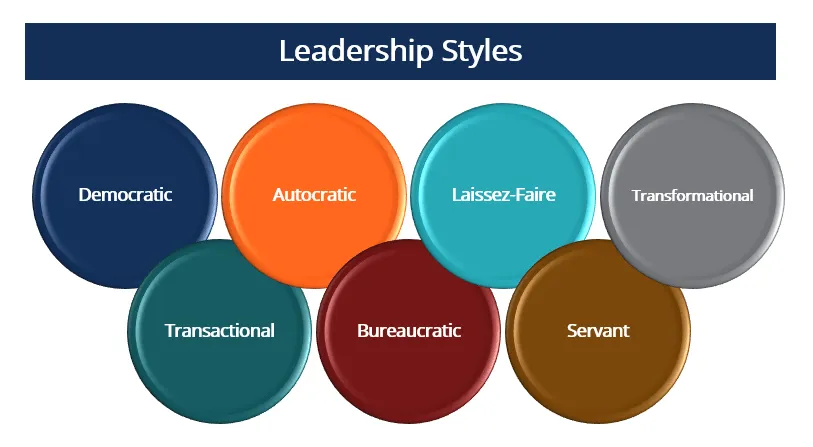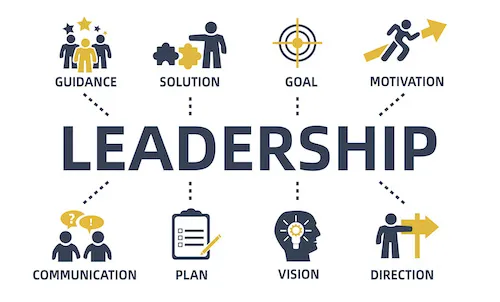What are Leadership Styles?
Leadership styles refer to the behavioural approach employed by leaders to influence, motivate, and direct their followers. A leadership style determines how leaders implement plans and strategies to accomplish given objectives while accounting for stakeholder expectations and the well-being and soundness of their team.
Leadership styles have been studied in various fora to establish the appropriate or most effective leadership style that motivates and influences others to accomplish set goals. The major tenet of effective leadership style is the degree to which it builds follower trust.
Studies carried out indicate that followers who trust in their leader are more likely to follow through with the leader’s instructions over and above the expected. In turn, they will accomplish set goals while being allowed to speak freely to air their ideas and suggestions on the direction of the projects at hand.
The leadership styles discussed in this article are based on studies and findings by several accomplished leadership researchers, which include Robert K. Greenleaf, Karl Lewis, Daniel Goleman, Bruce Avolio, and Bernard M. Bass.
Why Do Leadership Styles Matter?
A leadership style adopted by any leader is usually a combination of their personality, life experiences, level of emotional intelligence, family dynamics, and way of thinking. Thus, leaders should be able to understand their leadership style in relation to a combination of traits listed above and determine how best they can be more effective.
Effective leadership has more to do with leadership style. Hence, a leader’s ability to take charge and know whether a situation requires an executive decision or a more consultative one is vital. Furthermore, a leader needs to have the ability to know the most effective leadership style that is suitable for an organization or situation to succeed. Understanding one’s leadership style allows a leader to take ownership, control, and responsibility for the size and scope of the tasks ahead.
A study by Daniel Coleman in a Harvard Business Review article, Leadership That Gets Results, reviewed and analyzed more than 3,000 middle-level managers to find out specific leadership behaviours and their effect on profitability. The results revealed that a manager’s leadership style was responsible for 30% of the company’s bottom-line profitability.
An understanding of one’s leadership style and the ability to be flexible based on changing circumstances will likely result in the additional benefits below:
- Improvement in communication and collaboration
- Increase in employee engagement
- Strengthening of team effectiveness
- Leadership effectiveness becomes conspicuous in the organization leading to the recognition
Below are the most common leadership styles.

Common Leadership Styles
1. Democratic Leadership
A democratic leadership style is where a leader makes decisions based on the input received from team members. It is a collaborative and consultative leadership style where each team member has an opportunity to contribute to the direction of ongoing projects. However, the leader holds the final responsibility to make the decision.
Democratic leadership is one of the most popular and effective leadership styles because of its ability to provide lower-level employees a voice making it equally important in the organization. It is a style that resembles how decisions are made in company boardrooms. Democratic leadership can culminate in a vote to make decisions.
Democratic leadership also involves the delegation of authority to other people who determine work assignments. It utilizes the skills and experiences of team members in carrying out tasks.
The democratic leadership style encourages creativity and engagement of team members, which often leads to high job satisfaction and high productivity. However, establishing a consensus among team members can be time-consuming and costly, especially in cases where decisions need to be made swiftly.
2. Autocratic Leadership
Autocratic leadership is the direct opposite of democratic leadership. In this case, the leader makes all decisions on behalf of the team without taking any input or suggestions from them. The leader holds all authority and responsibility. They have absolute power and dictate all tasks to be undertaken. There is no consultation with employees before a decision is made. After the decision is made, everyone is expected to support the decision made by the leader. There is often some level of fear of the leader by the team.
The autocratic type of leadership style can be very retrogressive as it fuels employee disgruntlement since most decisions would not be in the employees’ interests. An example can be a unilateral increase in working hours or a change in other working conditions unfavourable to employees but made by leadership to increase production. Without employee consultation, the manager may not be fully aware of why production is not increasing, thereby resorting to a forced increase in working hours. It can lead to persistent absenteeism and high employee turnover.
However, autocratic leadership can be an effective approach in cases where the leader is experienced and knowledgeable about the circumstances surrounding the decision in question and where the decision needs to be made swiftly. There are other instances where it is also ideal such as when a decision does not require team input or an agreement to ensure a successful outcome.
3. Laissez-Faire Leadership
Laissez-faire leadership is accurately defined as a hands-off or passive approach to leadership. Instead, leaders provide their team members with the necessary tools, information, and resources to carry out their work tasks. The “let them be” style of leadership entails that a leader steps back and lets team members work without supervision and is free to plan, organize, make decisions, tackle problems, and complete the assigned projects.
The laissez-faire leadership approach is empowering employees who are creative, skilled, and self-motivated. The level of trust and independence given to the team can prove to be uplifting and productive and can lead to job satisfaction.
At the same time, it is important to keep such a type of leadership in check as chaos and confusion can quickly ensue if the team is not organized. The team can end up doing completely different things contrary to what the leader expects.
According to research, laissez-faire leadership is the least satisfying and least effective.
4. Transformational Leadership
Transformational leadership is all about transforming the business or groups by inspiring team members to keep increasing their bar and achieve what they never thought they were capable of. Transformational leaders expect the best out of their team and push them consistently until their work, lives, and businesses go through a transformation or considerable improvement.
Transformational leadership is about cultivating change in organizations and people. The transformation is done by motivating team members to go beyond their comfort zone and achieve much more than their perceived capabilities. To be effective, transformational leaders should possess high levels of integrity, emotional intelligence, a shared vision of the future, empathy, and good communication skills.
Such a style of leadership is often associated with high growth-oriented organizations that push boundaries in innovation and productivity. Practically, such leaders tend to give employees tasks that grow in difficulty and deadlines that keep getting tighter as time progresses.
However, transformational leaders risk losing track of individual learning curves as some team members may not receive appropriate coaching and guidance to get through challenging tasks. At the same time, transformational leaders can lead to high productivity and engagement through shared trust and vision between the leader and employees.
5. Transactional Leadership
Transactional leadership is more short-term and can best be described as a “give and take” kind of transaction. Team members agree to follow their leader on job acceptance; therefore, it’s a transaction involving payment for services rendered. Employees are rewarded for exactly the work they would’ve performed. If you meet a certain target, you receive the bonus that you’ve been promised. It is especially so in sales and marketing jobs.
Transactional leadership establishes roles and responsibilities for each team member and encourages the work to be completed as scheduled. There are instances where incentive programs can be employed over and above regular pay. In addition to incentives, there are penalties imposed to regulate how work should be done.
Transactional leadership is a more direct way of leadership that eliminates confusion between leader and subordinate, and tasks are clearly spelled out by the leader. However, due to its rigid environment and direct expectations, it may curb creativity and innovation. It can also lead to lower job satisfaction and high employee turnover.
6. Bureaucratic Leadership
Bureaucratic leadership is a “go by the book” type of leadership. Processes and regulations are followed according to policy with no room for flexibility. Rules are set on how work should be done, and bureaucratic leaders ensure that team members follow these procedures meticulously. Input from employees is considered by the leader; however, it is rejected if it does not conform to organizational policy. New ideas flow in a trickle, and a lot of red tape is present. Another characteristic is a hierarchical authority structure implying that power flows from top to bottom and is assigned to formal titles.
Bureaucratic leadership is often associated with large, “century-old” organizations where success has come through the employment of traditional practices. Hence, proposing a new strategy at these organizations is met with fierce resistance, especially if it is new and innovative. New ideas are viewed as wasteful ineffective, or even downright risky.
Although there is less control and more freedom than an autocratic leadership style, there is still no motivation to be innovative or go the extra mile. It is, therefore, not suitable for young, ambitious organizations on a growth path.
Bureaucratic leadership is suitable for jobs involving safety risks or managing valuable items such as large amounts of money or gold. It is also ideal for managing employees who perform routine work.
7. Servant Leadership
Servant leadership involves a leader being a servant to the team first before being a leader. A servant leader strives to serve the needs of their team above their own. It is also a form of leading by example. Servant leaders try to find ways to develop, elevate and inspire people following their lead to achieve the best results.
Servant leadership requires leaders with high integrity and munificence. It creates a positive organizational culture and high morale among team members. It also creates an ethical environment characterized by strong values and ideals.
However, other scholars believe servant leadership may not be suitable for competitive situations where other leaders compete with servant leaders. Servant leaders can easily fall behind more ambitious leaders. The servant leadership style is also criticized for not being agile enough to respond to tight deadlines and high-velocity organizations or situations.

Other Leadership Styles
1. Coach-style Leadership
Coach-style leadership involves identifying and nurturing individual strengths and formulating strategies for the team to blend and work well together, cohesively and successfully.
2. Charismatic Leadership
Charismatic leadership employs charisma to motivate and inspire followers. Leaders use eloquent communication skills to unite a team towards a shared vision. However, due to the charismatic leaders’ overwhelming disposition, they can see themselves as bigger than the team and lose track of the important tasks.
3. Strategic Leadership
Strategic leadership leads the company’s main operations and coordinates its growth opportunities. The leader can support multiple employee layers at the same time.
Which Leadership Style is the Best?
No one leadership style fits all organizations or situations. In addition, there is no one right way to lead, and there may be a need to switch between different leadership styles. It is therefore important to know all leadership styles and their pros and cons. The right leadership approach is often determined by the following factors:
- The type of organization, i.e., mature or growth-oriented
- The type of work involved, i.e., routine or creative
- The level of experience and skill of the team
- The personality of the leader
A consideration of the above factors will likely determine the appropriate leadership style to adopt or an appropriate combination of certain leadership styles.
